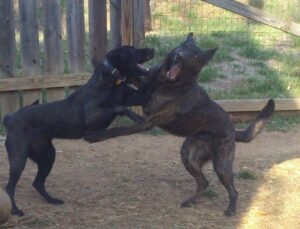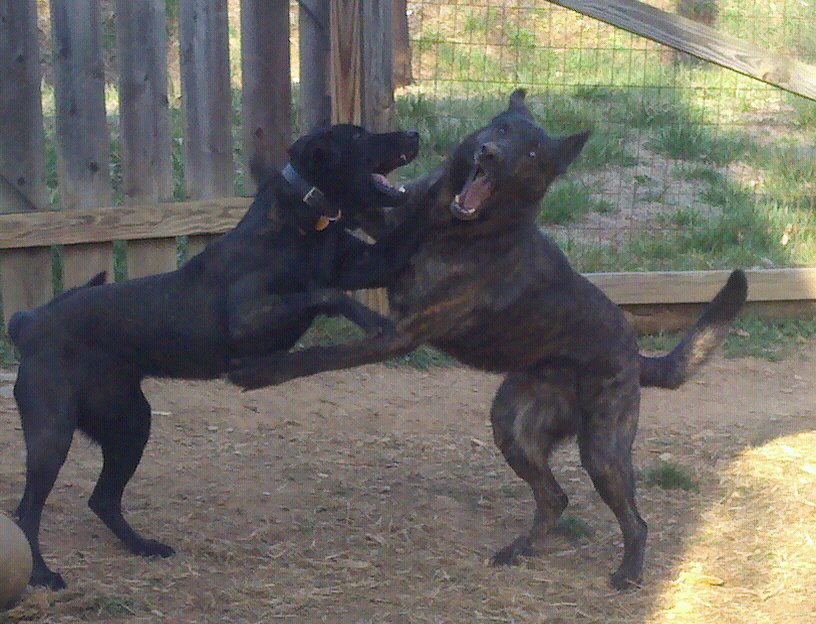
Managing multiple dogs in the same household can be rewarding, with effort and a training plan
Do you have multiple dogs?
Remember the Lays Potato Chip commercial? The tagline was “nobody can eat just one!” I know the ad dates me, but that should be a comfort and not a surprise for you youngsters who didn’t have the luxury of growing up in the saturated fat world of deep fried potato-y goodness.
People seem to think this applies to dogs, too. The more the merrier seems to be the prevailing mantra for people that have actively chosen a lifestyle that promotes being unattached and single. The problem with that is choosing to live with a dog has its own burdens, and choosing to live with multiple dogs doesn’t alleviate those problems, it compounds them.
There is a lot of really dangerous mythology that surrounds multiple dog ownership which has existed since time began. The notion that ‘they’ll be great company for each other’ is compounded by the fiction that multiple dogs will somehow train themselves or variations on a theme that involves one dog taking charge of the training and education of the new, potentially younger dog.
That’s not really how that works.
I do acknowledge where these myths may have arisen. Back in the day when humanity actually depended on dogs to facilitate hunting, herding and guarding tasks, we had them in numbers, and they were assimilated into functional groups where older, more experienced dogs were used to emulate certain desirable behaviors. Hunting dogs learned to mimic the more accomplished dogs, guarding dogs learned what and why to sound the alarms, and the herding dogs learned how to drive hoofstock at the heels of more finished workers.
However, it’s not that they didn’t have human influences throughout that learning process. Of course they did. That overzealous stock dog got clapped for mouthing his stock too much, and that hunting dog was taught what game not to chase. The guard dog learned what not to harass from the human, just like his compatriots did. Because dogs are not capable of those refined cognitive mapping skills without appropriate feedback.
It’s easy to see where the notion that dogs would keep each other company was given legs, because dogs lived in small groups with humans as they hunted and gathered their way into an agro-industrial society that needed them less and less.
But we’re here now, in the 21st Century, and with precious few exceptions, our dogs are companions, not employees. The rules that govern dog behavior have not changed, but our comprehension of it has diminished as we distance ourselves from the practicality of requiring any understanding of the wolf at our feet and on our couches.
Because multiple dogs are more than the minimalist understanding that we accord them. Because nobody can eat just one. They should come in pairs, like shoes, because of course it’s easier to take care of two. They take care of each other right? RIGHT?!
I often ask these people if they have siblings or childhood friends that they argued with, fought with or battled with. My sister and I fought like animals. We threw punches at each other, pulled hair, used weapons. Although it was never a healthy relationship to begin with, the point is the emotions that run hot in such confrontations color that relationship until it ends. All because of some perceived slight or oversight. Lives are ruined. Feelings are hurt. Nothing is ever the same.
Dogs exist outside any concept or understanding of morality. Their participation in linear social hierarchies are exceedingly transitory and tend to favor their placement or rank advantage, as opposed to the placement of others within that group. Call it what you want, but the pack dynamic lives.
In a multiple dog household, it is expected that these animals integrate in a way that is unnatural and rife with consequences.
In the wild, the ‘pack’ is essentially an extended family group comprised mostly of a mating male and female, older siblings, including pre-adolescent and adolescent males, and the occasional non-breeding adult male. The core wolf family is very similar to the traditional nuclear adult family.
In a domestic home, the additional dog is waltzing into an established dogs’ household and the established dog is expected to accept this without question.
It simply doesn’t happen that way.
It is very rare that the established dog is so accommodating that there are no immediate issues. Even when there is no outward sign of conflict, I can assure you, they are telegraphing information to each other that the average human is too disinterested to look for or recognize. When you add even more dogs, you are creating a cauldron of potential conflict that answer to a much more primordial law of governance.
I know many professionals that have multiple dogs in their household successfully. One in particular has a collection of unrelated animals ranging in age from 16 weeks to about 14 years, all of whom are allowed to intermingle, but not without human supervision, and not all at once. They are grouped in controllable numbers so they can be supervised by an individual that is greater in strength to their strongest member. Because there can be only one.
All of them have a reliable degree of off leash obedience and some of them have ‘histories’ as problem children.
In another, a generational group of intact bitches that cohabitate nicely. They are useful stock dogs with careers in S.A.R. and live a fulfilling life where their days and minds are occupied with meaningful work. They have been genetically selected for their proclivity to the task, and their impressive ability to live communally.
Each of these groups reflect cognitive decisions made by their respective owners, and each of these groups are managed in response to the requirements of each individual animal.
In the average human household, all of the mysticism and fairy tales take precedence, but none of the practicality or logistics of multiple dog ownership, and the burdens such an endeavor might entail.
Compound that with the average human’s inability to read the intricacies of dog behavior and pretty soon your tranquil, picturesque vision of the peaceable kingdom is shattered by multiple thousand-dollar vet bills and potential harm to the human members of the home.
When the reality of multiple dogs doesn’t match the mythology that surrounds them, the clashes can be pretty spectacular. Owners that have the misfortune of having to deal with multiple personalities are somehow always shocked to learn that they are suffering from the doggie version of multiple personality disorder. Because… Multiple personalities…
They are even more surprised when I tell them the dog with the most outward symptoms is rarely, of ever, the problem.
The provocative behavior of dog A is likely the response to the often imperceptible signals telegraphed by the other dog or dogs in the household.
It’s a powerplay after all. Either one is establishing their role in that linear hierarchy, or someone else is questioning it. Either way, owners with multiple dogs don’t have a ‘one-dog’ problem. They have a multiple dog problem. Add more dogs. Add more problems.
The answer is always more thorough training, to a high degree of reliability (and yes, this is obtainable) and better management. There is absolutely nothing stopping anyone with more than one dog, from being successful, except commitment and effort.
Are there extenuating circumstances that prevent success? Absolutely, but they are so rare, they represent an insignificant percentage overall. Certainly, an aging dog and emergent illness as that linear hierarchy begins to shift to more dynamic leadership is possible, but most often it’s too much competition for a limited amount of resources, just like it is in the wild.
Because people can’t judge dog needs without coloring their interpretations through that human lens of emotion.
“He’s being protective of me!” No, actually. He is defending his right to the optimal access to resources. How does it feel to be your dogs bitch?
“We have enough toys for everybody!” Carnivores don’t share. Haven’t you ever watched a Nature special? They will kill each other over food resources. It’s a survival tactic, so deeply encoded in their DNA that it is inescapable. In the Nature Is Raw, In Tooth And Claw department, it transfers to our well-fed, well-loved domestic dogs in the form of ‘resource guarding’ and defensive behavior over access to resources.

Carnivores don’t share
“But they have always gotten along!” No. No they really haven’t. Sleeping together in the same room isn’t getting along as much as it’s ‘not sweating the small stuff’. Because there has never been a contest over resources doesn’t mean that they ‘get along’. I guarantee ya, put the right kind of resource between them if you reaaaaaaaally want to test that theory. If you have multiple dogs and allow them to sleep on the Big Giant Dog Bed that doubles as your bed, I guarantee you’ve seen what I’m talking about.
“I have never seen this kind of behavior before!” (or it’s annoying cousin) “This [insert behavior] came out of nowhere!” Neither of these statements are even remotely true. I can assure you if you were running footage of every day of your dogs’ life for the last however long, you would be able to see the subliminal messages being thrown around like gang signs between them.
Assuming responsibility for even one animal is a monumental task. Assuming the health, safety and welfare of more than one at a time is a balancing act of temperance, common sense and a serious commitment to learning how to control each individual effectively before ever expecting to control them enmasse.
Humans have an obligation to become more than spectators in their dogs behavior. Owners need to become active influencers instead of passive participants in the outcomes those same behaviors facilitate. It is not a lot to ask or to expect our dogs to “get along”, but first, abandoning the fiction of some shibboleth from the deep recesses of time is as good a place to start as any.
Your dog is your responsibility. His behavior is, too.
If you find this content to be of value, feel free to leave a comment and don’t be afraid to share!


Very good Linda! I stay on top of this with as many as four dogs in the house. Two West Siberian Laika females 12 and three, a Cane Corso male neutered five, and until recently a female South African Boerboel (unfortunately my sweet Chi Chi had to be put down with cancer at five not fun). My life has been spent with various hunting breeds of about any type that hunt everything to small game to the biggest game in North America. I am constantly managing and have handled each of their obedience leash and off leash as well as the Laikas hunting. It is a serious commitment on my end to ensure that what is allowed and what isn’t out of the dogs. I put myself as a trainer not even close to you as a hunting dog guy I am very knowledgeable. The one thing most people do not understand dogs that did not fit into the group hunting, herding, or guarding were culled. Only the best were kept. In today’s world it is not like that and people often refer to dogs as sisters and brothers. This is not the case as we have introduced human thoughts and emotions on dogs. It truly isn’t fair to dogs as they each are still what humans have a tough time understanding that they are their own species.
Folks think they want more than one dog. What they want is some idea of the peaceable kingdom where all God’s Creatures get along in some fantasy world.
We have three, soon to be four. It’s work. It’s a lot of work. Even when it’s cold, or rainy, or hot or any other inconvenience.
Great article! I’ve had as many as 4 dogs that ranged in ages from a 10 wk old pup to a 13yo GSD and size from 19 lbs to 150 lbs. It took a lot of work, but yes, they did learn to get along, although management between the pup and the sr citizen was constant. Every time you add, or lose, a “pack member” there is a time of adjustment that can take a lot longer than you think it will! As you said, it takes work and commitment. Wish the average pet owner would realize and accept that!
This is a great article! Your line, “dogs are not capable of such refined cognitive mapping skills without appropriate feedback” is right on target but so well stated.
Great article. Thank you
I really appreciate this line,
“ “He’s being protective of me!” No, actually. He is defending his right to the optimal access to resources. How does it feel to be your dogs bitch?”
Thanks, folks! I really appreciate the feedback!
Great article – thanks Linda!
Excellent